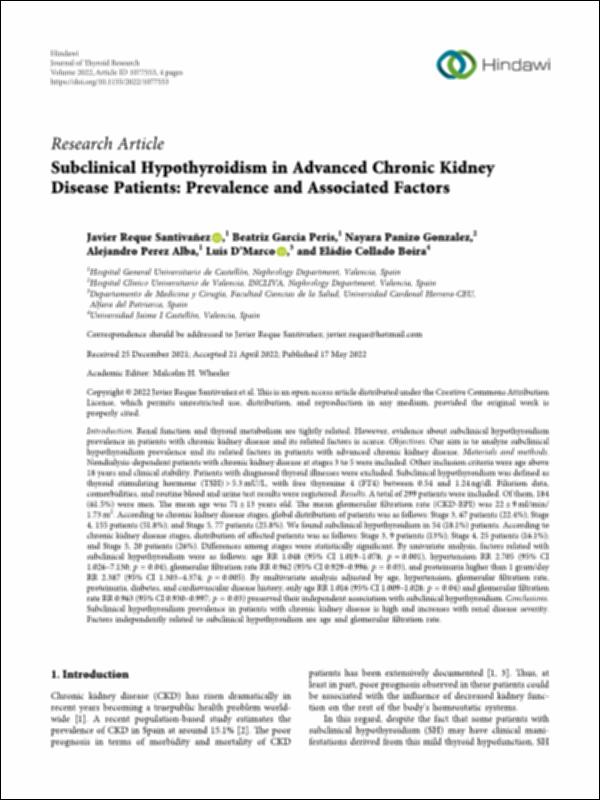Please use this identifier to cite or link to this item:
http://hdl.handle.net/10637/14389Subclinical hypothyroidism in advanced chronic kidney disease patients: prevalence and associated factors
| Title: | Subclinical hypothyroidism in advanced chronic kidney disease patients: prevalence and associated factors |
| Authors : | Reque Santiváñez, Javier García Peris, Beatriz Panizo González, Nayara Pérez Alba, Alejandro D'Marco Gascón, Luis Gerardo Collado Boira, Eladio Joaquín |
| Keywords: | Diabetic nephropaties.; Albuminuria.; Hypothyroidism.; Hipotiroidismo.; Diabetes - Complicaciones y secuelas. |
| Publisher: | Hindawi |
| Citation: | Reque Santivañez, J., Garcia Peris, B., Panizo Gonzalez, N., Perez Alba, A., D'Marco, L. & Collado Boira, E. (2022). Subclinical hypothyroidism in advanced chronic kidney disease patients: prevalence and associated factors. Journal of Thyroid Research, vol. 2022, art. 1077553 (17 may.). DOI: https://doi.org/10.1155/2022/1077553 |
| Abstract: | Introduction. Renal function and thyroid metabolism are tightly related. However, evidence about subclinical hypothyroidism prevalence in patients with chronic kidney disease and its related factors is scarce. Objectives. Our aim is to analyze subclinical hypothyroidism prevalence and its related factors in patients with advanced chronic kidney disease. Materials and methods. Nondialysis-dependent patients with chronic kidney disease at stages 3 to 5 were included. Other inclusion criteria were age above 18 years and clinical stability. Patients with diagnosed thyroid illnesses were excluded. Subclinical hypothyroidism was de ned as thyroid stimulating hormone (TSH) > 5.3 mU/L, with free thyroxine 4 (FT4) between 0.54 and 1.24 ng/dl. Filiation data, comorbidities, and routine blood and urine test results were registered. Results. A total of 299 patients were included. Of them, 184 (61.5%) were men. The mean age was 71 ± 13 years old. The mean glomerular fltration rate (CKD-EPI) was 22 ± 9 ml/min/ 1.73m2. According to chronic kidney disease stages, global distribution of patients was as follows: Stage 3, 67 patients (22.4%); Stage 4, 155 patients (51.8%); and Stage 5, 77 patients (25.8%). We found subclinical hypothyroidism in 54 (18.1%) patients. According to chronic kidney disease stages, distribution of affected patients was as follows: Stage 3, 9 patients (13%); Stage 4, 25 patients (16.1%); and Stage 5, 20 patients (26%). Di¤erences among stages were statistically signifcant. By univariate analysis, factors related with subclinical hypothyroidism were as follows: age RR 1.048 (95% CI 1.019–1.078; p = 0.001), hypertension RR 2.705 (95% CI 1.026–7.130; p = 0.04), glomerular fltration rate RR 0.962 (95% CI 0.929–0.996; p = 0.03), and proteinuria higher than 1 gram/day RR 2.387 (95% CI 1.303–4.374; p = 0.005). By multivariate analysis adjusted by age, hypertension, glomerular fltration rate, proteinuria, diabetes, and cardiovascular disease history, only age RR 1.016 (95% CI 1.009–1.028; p = 0.04) and glomerular fltration rate RR 0.963 (95% CI 0.930–0.997; p = 0.03) preserved their independent association with subclinical hypothyroidism. Conclusions. Subclinical hypothyroidism prevalence in patients with chronic kidney disease is high and increases with renal disease severity. Factors independently related to subclinical hypothyroidism are age and glomerular fltration rate. |
| Description: | Este artículo se encuentra disponible en la siguiente URL: https://downloads.hindawi.com/journals/jtr/2022/1077553.pdf |
| URI: | http://hdl.handle.net/10637/14389 |
| Rights : | http://creativecommons.org/licenses/by/4.0/deed.es |
| ISSN: | 2090-8067 2042-0072 (Electrónico) |
| Language: | es |
| Issue Date: | 17-May-2022 |
| Center : | Universidad Cardenal Herrera-CEU |
| Appears in Collections: | Dpto. Medicina y Cirugía |
Items in DSpace are protected by copyright, with all rights reserved, unless otherwise indicated.


